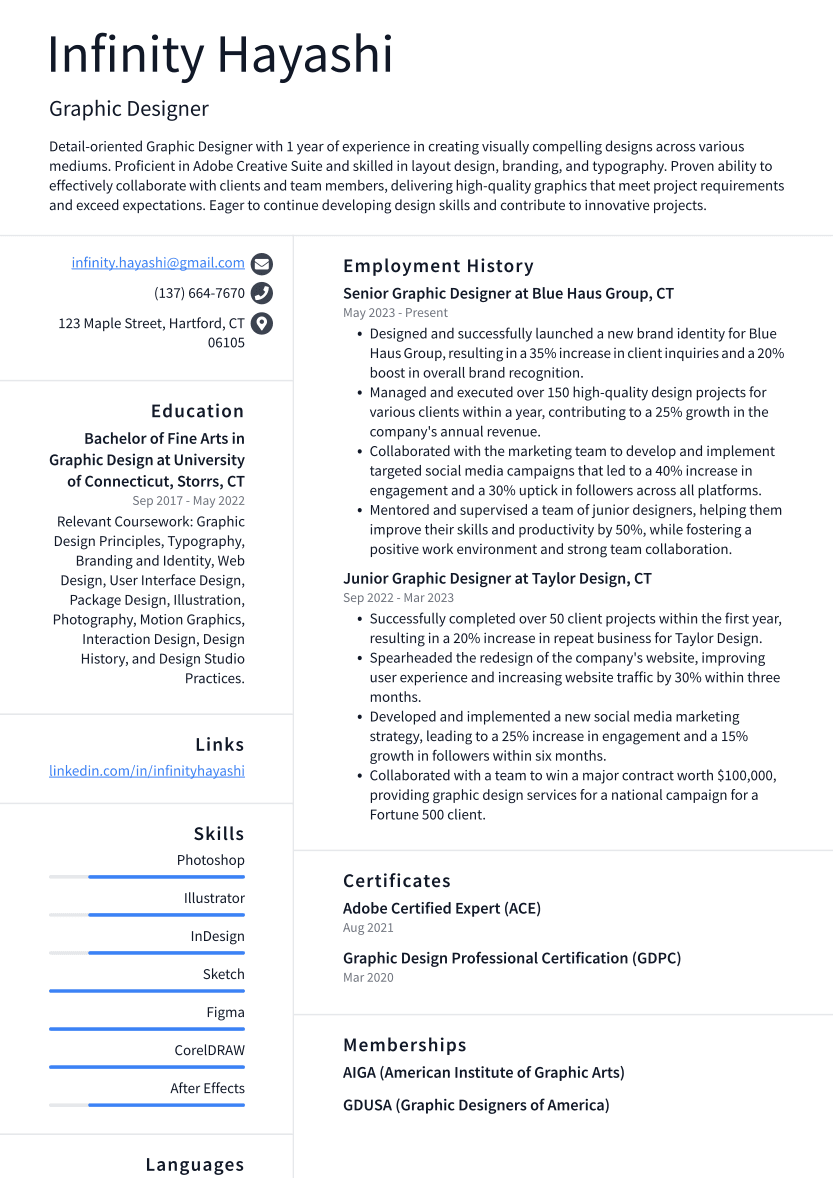Graphic Designer Resume Examples
Writing a great graphic designer resume is important because it is one of the first things a potential employer will see when they are considering you for a position. It is your opportunity to make a good first impression and sell yourself as the best candidate for the job.
Create your resume
Select from 7 professional resume templates
If you're looking for inspiration when it comes to drafting your own graphic designer resume, look no further than the samples below. These resumes will help you highlight your experience and qualifications in the most effective way possible, giving you the best chance of landing the graphic designer job you're after.
Essential Components of a Graphic Designer's Resume
For graphic designers, a resume isn't just a formality; it's a canvas to showcase their blend of artistic talent, technical proficiency, and professional experience. A compelling resume can be the ticket to landing interviews and making a strong impression on potential employers. Let's explore the critical elements that make a graphic designer's resume stand out.
1. Contact Information
At the top of your resume, ensure your contact information is prominent and professional. Include your name, title (Graphic Designer), current address, phone number, and email. Indicate your willingness to work remotely or relocate if that's the case. Additionally, link to your online portfolio or LinkedIn profile to give employers a preview of your work.

- Use a professional email address based on your name.
- Ensure your online presence is employer-friendly.
Keep this section succinct, offering multiple contact methods without overwhelming the reader.
2. Objective or Summary Statement
The Objective or Summary Statement serves as your resume's introduction, highlighting your skills, experience, and career goals. An objective statement is ideal for those new to the field, while a summary statement suits experienced professionals, showcasing career highlights and key competencies.
- Objective Statement: Focus on your career aspirations and how you can contribute to the company.
- Summary Statement: Summarize your professional achievements and graphic design expertise.
Use relevant keywords and tailor this section to each job application to capture the hiring manager's attention.
3. Skills and Proficiencies
The Skills and Proficiencies section is your opportunity to display your technical and creative abilities. Highlight your proficiency with design software, understanding of design principles, and soft skills like communication and teamwork.
- Technical skills, such as Adobe Creative Suite and web design tools.
- Design skills, including color theory, typography, and layout design.
- Creativity and the ability to produce unique designs.
- Effective communication and the ability to articulate ideas and receive feedback.
- Time management skills for handling multiple projects.
- Attention to detail to ensure precision in designs.
- Problem-solving skills for developing visual solutions.
- Teamwork abilities for collaborating with various stakeholders.
- Business and marketing knowledge to create strategic designs.
- Adaptability to stay current with design trends and technology.
Provide concrete examples of how you've applied these skills in practice.
4. Work Experience
The Work Experience section chronicles your professional journey. List your roles in reverse chronological order, emphasizing achievements and contributions rather than just responsibilities. Include any relevant freelance or internship experiences, as they demonstrate initiative and skill development.
- Use action verbs to bring your experiences to life.
- Customize this section to align with the job description.
- Link to your online portfolio to showcase your work.
- Be honest about your experiences and avoid exaggeration.
Your work history should tell the story of your unique approach to design.
5. Portfolio of Work
A work portfolio is a visual testament to your skills and versatility as a graphic designer. Include a variety of work samples, such as logos, website designs, and print materials, to demonstrate your range. Accompany each piece with a brief description of the project's goals and outcomes.
While an online portfolio is convenient for updates, also have a PDF version ready for interviews. Focus on quality over quantity, ensuring your portfolio reflects your best work and potential for future projects.
6. Education and Certifications
Your Education and Certifications provide insight into your formal training and continued learning. List degrees, relevant coursework, and any certifications that enhance your qualifications as a graphic designer. Highlight skills acquired through your education that are pertinent to the job you're seeking.
- Formal education, such as a Bachelor's degree in Graphic Design.
- Relevant courses taken outside of your primary field of study.
- Certifications from recognized institutions or online platforms.
- Additional workshops or training sessions attended.
While education is important, practical skills and experience often carry equal weight in the design industry.
7. References or Testimonials
References or testimonials add credibility to your resume by validating your skills and work ethic. Choose references who can speak positively about your graphic design capabilities and ensure you have their consent before listing them. If you're new to the field, consider including educators or mentors as references.
Testimonials from well-known brands or satisfied clients can be particularly impactful. Ensure your references can provide detailed insights into your contributions and effectiveness as a designer.
Incorporating these elements into your graphic designer resume will create a comprehensive and engaging profile that captures the attention of employers and sets you apart in the competitive design industry.
